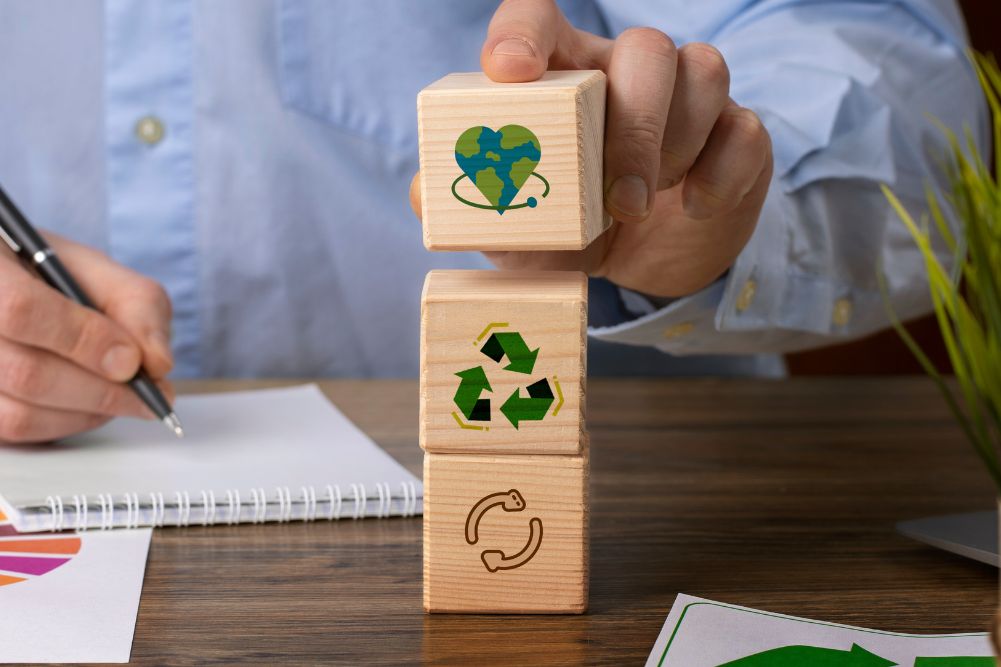Introduction:
As concerns about environmental sustainability grow, businesses across the globe are looking for ways to reduce waste and minimize their environmental impact. The concept of the circular economy offers a promising solution. Unlike the traditional linear economy, which follows a “take, make, dispose” model, the circular economy emphasizes designing out waste and keeping products and materials in use for as long as possible. In this blog, we explore how the circular economy is reshaping business strategies, the benefits it brings, and how companies can implement circular practices to reduce waste and drive long-term value.
What is the Circular Economy?
The circular economy is a system that focuses on minimizing waste and making the most of resources. Rather than following the traditional model of producing goods, consuming them, and then disposing of them, the circular economy encourages businesses to extend the lifecycle of products through reuse, repair, refurbishment, remanufacturing, and recycling.
In a circular economy, materials are kept in circulation, creating a closed-loop system that reduces the need for raw materials and minimizes waste. By designing products with durability and recyclability in mind, businesses can reduce their environmental impact and contribute to a more sustainable future.
The core principles of the circular economy include:
- Designing for Longevity: Products are designed to last longer, be repaired, and be reused or repurposed rather than discarded after a single use.
- Maintaining Product Value: Instead of allowing products to lose value through disposal, businesses find ways to extend their lifecycle by refurbishing or remanufacturing them.
- Minimizing Resource Use: By using fewer resources and finding ways to reuse or recycle materials, businesses can reduce their environmental impact.
- Waste as a Resource: Waste is viewed not as a byproduct, but as a resource that can be reintroduced into the production process.
Why the Circular Economy Matters for Businesses
The shift toward a circular economy is not just a matter of environmental responsibility—it also makes good business sense. Here are some of the key reasons why businesses are embracing the circular economy:
- Cost Savings: Reducing waste and reusing materials can lead to significant cost savings for businesses. By extending the lifecycle of products and materials, companies can reduce their reliance on expensive raw materials. Additionally, optimizing resource use can lead to reduced energy consumption and lower operational costs.
For example, global apparel brand Patagonia has long embraced circular economy principles by offering repair services and encouraging customers to recycle their old gear. This has allowed Patagonia to reduce production costs while promoting sustainability.
- Regulatory Compliance: Governments around the world are increasingly introducing regulations aimed at reducing waste and promoting sustainability. Businesses that adopt circular economy practices are better positioned to comply with these regulations and avoid potential penalties. For example, the European Union’s Circular Economy Action Plan includes measures aimed at reducing waste, promoting product longevity, and increasing recycling rates across various industries.
- Consumer Demand: Consumers are becoming more environmentally conscious, and they are increasingly seeking out products and brands that prioritize sustainability. Businesses that adopt circular economy principles can differentiate themselves in the market and attract environmentally conscious customers. A 2020 Nielsen study found that 73% of global consumers are willing to change their consumption habits to reduce their environmental impact.
- Innovation and Competitive Advantage: The circular economy encourages innovation by challenging businesses to rethink traditional production methods and find new ways to create value. Companies that embrace circular practices are often seen as leaders in sustainability, which can enhance their brand reputation and create a competitive advantage.
How Companies are Embracing the Circular Economy
Many companies across various industries are already adopting circular economy principles. Here are some real-world examples of businesses successfully implementing circular practices:
- IKEA: IKEA, the world’s largest furniture retailer, has made a significant commitment to the circular economy. The company has launched several initiatives to extend the life of its products, including a furniture buy-back program that allows customers to return their used furniture in exchange for store credit. IKEA then refurbishes and resells the furniture, keeping it in circulation and reducing the need for new raw materials. Additionally, IKEA has committed to becoming a fully circular business by 2030, meaning that all of its products will be made from renewable or recycled materials.
- Philips: Philips, a global leader in healthcare and lighting, has integrated circular economy principles into its business model by offering product-as-a-service solutions. Rather than selling lighting fixtures outright, Philips provides lighting as a service, where customers pay for the light they use rather than owning the equipment. This model encourages Philips to design durable, energy-efficient products that can be maintained, upgraded, and recycled, ensuring that resources are kept in circulation for as long as possible.
- Unilever: Unilever, a multinational consumer goods company, is committed to reducing waste through its “Waste-Free World” initiative. The company aims to make all of its plastic packaging reusable, recyclable, or compostable by 2025. Additionally, Unilever is investing in refillable product solutions, such as refill stations for its beauty and personal care products, which allow customers to reuse their containers rather than buying new ones. This reduces packaging waste and helps Unilever move toward a more circular business model.
- Dell Technologies: Dell has embraced the circular economy by focusing on product recovery and recycling. The company offers a take-back program for used electronics, ensuring that valuable materials such as metals and plastics are recovered and reintroduced into the manufacturing process. Dell also uses recycled materials in its products, including ocean-bound plastics, which help reduce the environmental impact of its supply chain.
The Benefits of Implementing Circular Economy Practices
Adopting circular economy practices brings a range of benefits for businesses, including:
- Reduced Environmental Impact: By keeping materials in circulation and reducing waste, businesses can significantly lower their carbon footprint and reduce their reliance on finite resources. Circular economy practices help conserve natural resources, reduce pollution, and mitigate the effects of climate change.
- Increased Resource Efficiency: Circular practices encourage businesses to use resources more efficiently, which can lead to cost savings and increased profitability. By extending the life of products and materials, businesses can reduce the need for new raw materials and lower production costs.
- New Revenue Streams: The circular economy opens up opportunities for businesses to create new revenue streams through services such as product refurbishment, leasing, or take-back programs. For example, companies can generate additional revenue by offering maintenance and repair services for their products or by reselling refurbished goods.
- Stronger Customer Relationships: Circular economy practices can help businesses build stronger relationships with their customers by offering value-added services such as product take-back programs, repair services, and recycling options. These initiatives not only enhance customer loyalty but also position businesses as leaders in sustainability.
Challenges in Adopting the Circular Economy
While the circular economy offers significant benefits, there are challenges that businesses must overcome to fully implement circular practices:
- Initial Costs: Transitioning to a circular economy model often requires upfront investment in new technologies, processes, and systems. For example, businesses may need to invest in product redesign, recycling infrastructure, or reverse logistics systems to manage product returns and refurbishment. These initial costs can be a barrier for some businesses, particularly small and medium-sized enterprises (SMEs).
- Complex Supply Chains: Implementing circular practices requires coordination across complex supply chains. Businesses must work closely with suppliers, manufacturers, and customers to ensure that products are designed for longevity and that materials can be reused or recycled at the end of their lifecycle. This requires transparency, collaboration, and a willingness to adopt new business models.
- Consumer Behavior: While many consumers are becoming more environmentally conscious, changing consumer behavior can be a challenge. For example, encouraging customers to return products for refurbishment or recycling requires education and incentives. Businesses must invest in marketing and awareness campaigns to promote circular economy initiatives and encourage participation.
Conclusion:
The circular economy represents a significant opportunity for businesses to reduce waste, enhance resource efficiency, and drive long-term value. By embracing circular practices, companies can reduce their environmental impact, build stronger customer relationships, and create new revenue streams. While there are challenges to overcome, the benefits of adopting a circular economy model far outweigh the costs. As the demand for sustainable products and services continues to grow, businesses that prioritize circular economy practices will be well-positioned to succeed in the future.




